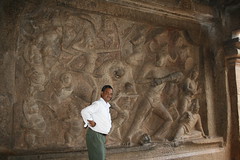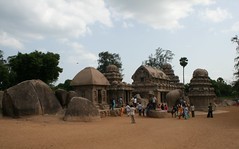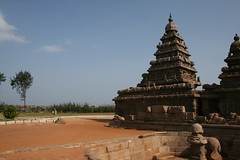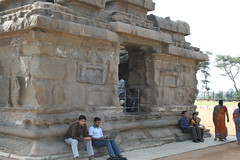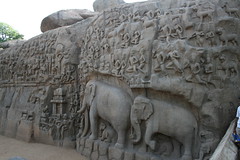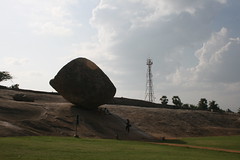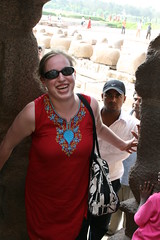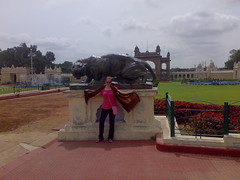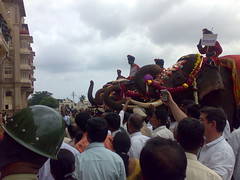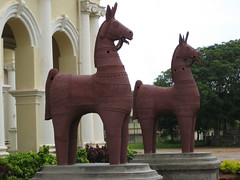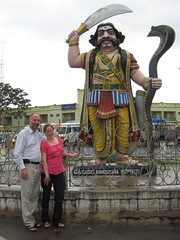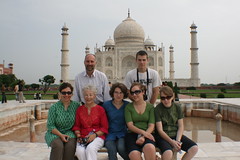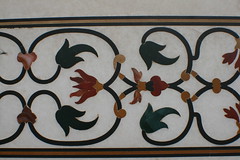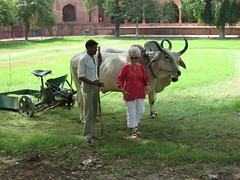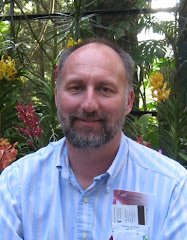From Jaipur the next morning, we left for Agra. It was to be a 5 hour drive, with a stop at Fatehpur Sikri along the way. The ride was interesting from the perspective of the different landscape and people in Rajestan. For instance Camels, in the rain, not something you normally associate together.

In this case, I'm not sure it was raining at the time, but it had just rained as the ground was very muddy. This camel was tied alongside the road. We saw many, some were pulling carts, others were just waiting for work.
Another thing, although in south India, many objects, i.e. trucks, are decorated, there is much more decoration in Rajestan.

This truck was typical of many we saw. It is beautifully decorated. Also many of the smaller trucks/jeeps didn't have covers for the engine, and the driver sat directly behind the exposed engine. Also this could have been used for public transport, it would have carried about 30 people, standing in the back. We saw a lot of this.
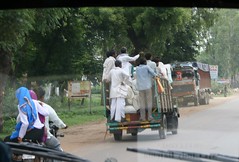
There was a lot of work on the road. It is apparently being improved for the Commonwealth games which will be held in India in a couple of years. The road needed updating. Most of it was 2 lanes wide, and they are adding another 2.

In this case the bridge here (a new one is being constructed next to it), was literally falling apart. You can see the missing parts of the railing. Some of the brick sections were wobbling from side to side as we drove past, and I was wondering when they would just wobble into the river below.
We also saw a lot of local color. Many people doing various kinds of business, or living along the roadway. I caught these two women from the bus as we were driving by.

And also these two women who were obviously grooming one's hair.

We even passed by a local livestock market. There were many men and boys with their sheep or goats. They were just hanging out, loading them into or off of carts/trucks, and generally conducting business. I thought these were particularly colorful animals.

Finally we made it to
Fatehpur Sikri a city which was built by the Moghul Akbar in the mid 16th century. He only lived there for a little over a decade. Apparently water was a problem. It needed to be carried up from the river as the wells on the hilltop didn't yield much. I won't describe all the historical info, go to one of the official sites for that. Here are a couple of photos from the site. It is a stunning place. It was built to celebrate the birth of a son to the Moghul.
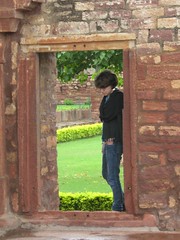
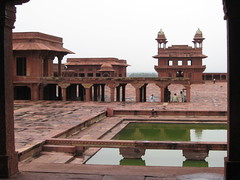
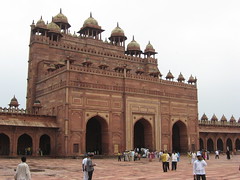

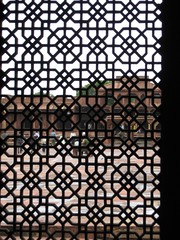
We met our second guide there before going in. He wasn't as good as the first one, though he did know his stuff, he repeated himself a lot. He knew more about the Taj the next day too. On the way down from the hilltop (we took a bus up), he decided that we would all fit into one rickshaw.

Cindy took a couple of photos, obviously Conner was too tall and had to stick his head out...

Thanks Cindy for letting me steal your photos. There were 10 of us in the Rickshaw (including the driver).
Agra:After Fatehpur Sikri, we went on to Agra, only about another hour's drive. There we saw the Red Fort before checking into the Hotel.
The Red Fort starts with an impressive defensive structure--

there are two moats, followed by a drawbridge/gate and then a long walk up between two high walls.

The long walk is exposed to spots where one could be shot at from defensive positions, and where hot oil or water could be poured out onto the invaders. Much of the fort is still occupied by the Indian Army,and is off limits. But it is possible to visit the parts where the Mogul who built the Taj Mahal was imprisoned by his son for creating a monument that didn't follow the strict guidelines of the Muslim beliefs. He was supposedly imprisoned in an area where there is a view of the Taj Mahal.
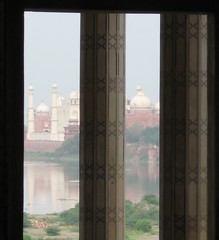
There are also beautiful gardens, many buildings with beautiful arches and other things to see there. Check out the
Flickr page for all my photos-I didn't take many. It was a long day and by closing time, we were ready to head to the hotel and relax, have dinner and get ready for the Taj Mahal the next day.
 an Ashram-where I didn't get many pictures, and the market where I did get a lot...
an Ashram-where I didn't get many pictures, and the market where I did get a lot...





 and here you can see the influence of the French. They didn't like to buy food off the ground...
and here you can see the influence of the French. They didn't like to buy food off the ground... 

